 This pile of ironing represents two books of Paradise Lost, the audiobook, read by the heavenly Anton Lesser, who I think was probably born to read Paradise Lost aloud. Lovely sister lent it to me when I was visiting.
This pile of ironing represents two books of Paradise Lost, the audiobook, read by the heavenly Anton Lesser, who I think was probably born to read Paradise Lost aloud. Lovely sister lent it to me when I was visiting.I have written before I think, of the benefits of the heavier-weight classics of English literature to listen to when one has ironing to do. Milton may not yet have succeeded in justifying God's ways to me, or leastways not the ways of patriarchal religion in blaming it all on the woman, but he does justify spending a chilly March afternoon ironing to the rhythms of the great epic.
I often relate what's been going on to Tom in the demotic. For example, Book 5,
'So, Adam said to Raphael (sociable spirit, affable archangel, you know the one), Eve's just whipping up something tasty, no need to worry about it getting cold as there's no hot food in Eden. Do you fancy some or do you angels not eat stuff like we do?"
And Raphael said "Don't mind if I do." '
Or, Book 8,
'Then Adam asked, "What about the stars, I've heard there's this bloke Galileo, and it makes you wonder... " but Raphael quickly cuts in with "That's on a need-to-know basis. You don't need to know." '
Occasionally, after a lengthy period of immersion, the process starts working in reverse, and I find myself talking about everyday matters in Miltonian blank verse. So when Tom says 'I hope my car's OK where I parked it.' I reply along the lines of
'Thus questioned Thomas, trembling lest
Some arch fiend or malignant spirit should
His argent chariot scrape or otherwise impair...'
But this is unusual.
~~~
Dear Michelle asked after Molly. She had a checkup the other day, since it's a month since she came off the injections. Her regular vet says there's no sensitivity around the ear, and she seems well. She certainly is lively and full of the joys of spring, as, oh so tentatively, are we. This isn't an especially good photo, as she's barking and it's a bit dark. She saw me photographing the ironing (above) and started jumping around in front of me and barking, as she does when she sees me wielding the camera indoors, presumably thinking she should be the centre of attention. She's looking somewhat scruffy and her ears are still lopsided from the op, but I've made an appointment at the poodle parlour to get her tidied and evened up a bit at the end of next month.




.jpg)
















































